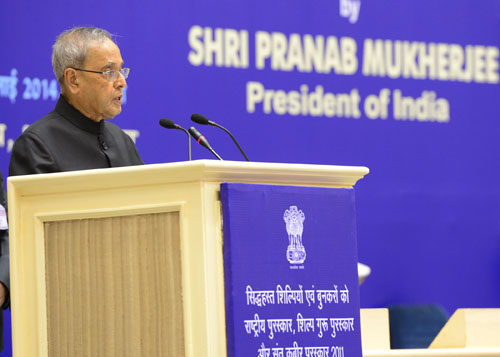
It is indeed a matter of satisfaction for me to join you today in conferring the prestigious National Awards, Shilpguru Awards and Sant Kabir Awards to outstanding weavers and artisans for the year 2011.
2. I would like to, first of all, congratulate the awardees and express my deep appreciation of their contribution to the preservation and promotion of India’s handloom and handicrafts industry. I am confident that their endeavours shall encourage and inspire many.
3. Ladies and gentlemen, our indigenous handicrafts and handlooms are a cherished aspect of the Indian way of life. Their extensive range reflects our nation’s diversity and infinite creativity. Each geographic region - and sub-region even - has its individual style and tradition - that stems from the ancient life-rhythms of its society. In every case, local materials and resources are used. Our shilpkaars have, down the ages, developed their own - often unique – methods and techniques to bring life into stone, metal, sandalwood and clay. They had, a very long time ago, perfected scientific and engineering processes far ahead of their times. Their creations revealed their sophisticated knowledge and highly developed aesthetic sense. Similarly, the level of artistry and intricacy achieved by our weavers over the years is unparalleled and many traditional weavings remain beyond the capability of modern machines.
4. These skills have sustained generations and provided livelihood and stimulated socio-economic development at the very grassroots of our society. This sector has contributed substantially to the empowerment of women, the youth and the disabled. Women are a large part of the work force in the weaving sector and, women constitute over 50% of the artisans’ sector. A considerable percentage of weavers and artisans belong to the Scheduled Castes and Tribes and religious minorities. This sector not only provides low investment income opportunities for families in the rural sector but it also supplements their incomes in off-season of Agriculture. Vitality in this sector checks migration and helps to keep traditional economic relationships intact. It is significant that the handlooms sector in India, with 24 lakh handlooms, provides employment to about 44 lakh persons and our handicrafts sector provides employment to about 70 lakh persons. The Textile Sector provides largest employment opportunities next to Agriculture. Between 2010 and the present, it is seen that despite the overall slowdown in the Indian economy there was a growth of 34% in exports from the handlooms sector and 126 % in the exports from the handicrafts sector.
5. However, it cannot be ignored that this sector, despite its wide production base, has been constrained in its growth. It has been disadvantaged by its inadequate access to credit, dependence on middlemen, inadequate availability of raw material, out-dated technology and limited access to markets. The products in this sector remain vulnerable to competition from cheaper imports and machine made substitutes. These factors need to be addressed urgently, systematically and comprehensively and we must give more attention to development of capacity, skills, designs and infrastructure.
6. It is important to recall that the founding fathers of our nation had recognized the importance of safeguarding handicrafts and handlooms in the long term. They had introduced a number of measures to ensure its sustainability including well-conceived initiatives, national-level programmes and supportive legislations. I would like to emphasise that it is crucially important for us, today, to do all that we can to honour their dream. We must take concerted and collective steps at multiple levels. These could include, for example, facilitation of easier access of these sectors to credit from banks and other financial institutions and the promotion of the products of these sectors in domestic and foreign markets. I firmly believe that universities, corporate sector and Government departments can contribute by sponsoring - and themselves taking up - research that results in innovative technology to adapt and upgrade the traditional tools and designs of the local artisans, and weavers.
7. And there are many factors in our favour. The abundant availability of unusual raw materials in India - such as bamboo, horn, jute, a pool of skilled artisans and indigenous knowledge has kept our production costs low. Government is working on more enabling policies in the 12th Five Year Plan. Many who had left the handloom and handicrafts sector have begun to revert. This is a good indication that Governmental interventions so far have been effective. It is, however, necessary for all concerned Ministries and Departments to stay vigilant and respond promptly to demand in existing and emerging markets.
8. Ladies and Gentlemen, our "guru shishya parampara” is another exceptional aspect of our traditional art and crafts. Master-craftsmen and weavers, down the ages, have taken pride in passing on their skill to their succeeding generations. Gandhiji had, in fact, a very clear view on this and considered handicrafts to be a vital part of education. He had said - and I quote, "if we want to keep all seven lakhs of our villages alive and not only a fraction of them, we have to revive our village handicrafts. And you may be sure that if we impart scholastic training through those crafts, we can bring about a revolution”.
9. As I leave these thoughts with you, I would like to thank the Ministry of Textiles for instituting these awards. I would like to, once again, congratulate the craft persons and weavers who have received awards today. I take this opportunity to convey to you - and through you - my felicitations to all the members of the handicrafts and handlooms community in all parts of our nation. I offer you all my best wishes for your creative work in the years to come.
Jai Hind.
